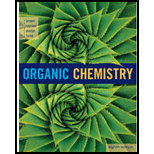
(a)
Interpretation:
The type of isomers in limonene has to be identified.
Concept Introduction:
Chiral carbon: A carbon is said to be chiral carbon if it is bonded to four different substituents.
Chirality: It refers to a Carbon atom in a molecule that contains four different substituents.
Enantiomers: They are chiral molecules whose mirror images are not superimposable.
(b)
Interpretation:
Possibility of having E, Z isomers in limonene has to be identified.
Concept Introduction:
Geometric isomers: Two compounds are considered as geometric isomers of each other if both contain same number of atoms but different in their arrangement.
E configuration: The geometric isomers are given E configuration if high priority groups are placed on opposite sides of the double bond.
Z configuration: The geometric isomers are given Z configuration if high priority groups are placed on same sides of the double bond.
(c)
Interpretation:
Reason for why isomers of limonene smell differently has to be explained.
Concept Introduction:
Chiral carbon: A carbon is said to be chiral carbon if it is bonded to four different substituents.
Chirality: It refers to a Carbon atom in a molecule that contains four different substituents.
Enantiomers: They are chiral molecules whose mirror images are not superimposable.
Trending nowThis is a popular solution!

Chapter 5 Solutions
ORGANIC CHEMISTRY-OWL V2 ACCESS
- Please help me solve this reaction.arrow_forwardIndicate the products obtained by mixing 2,2-dimethylpropanal with acetaldehyde and sodium ethoxide in ethanol.arrow_forwardSynthesize 2-Ethyl-3-methyloxirane from dimethyl(propyl)sulfonium iodide using the necessary organic or inorganic reagents. Draw the structures of the compounds.arrow_forward
- Synthesize 2-Hydroxy-2-phenylacetonitrile from phenylmethanol using the necessary organic or inorganic reagents. Draw the structures of the compounds.arrow_forwardSynthesize N-Methylcyclohexylamine from cyclohexanol using the necessary organic or inorganic reagents. Draw the structures of the compounds.arrow_forwardSynthesize N-Methylcyclohexylamine from cyclohexanol using the necessary organic or inorganic reagents. Draw the structures of the compounds.arrow_forward
- If possible, please provide the formula of the compound 3,3-dimethylbut-2-enal.arrow_forwardSynthesize 1,4-dibromobenzene from acetanilide (N-phenylacetamide) using the necessary organic or inorganic reagents. Draw the structures of the compounds.arrow_forwardIndicate the products obtained by mixing (3-oxo-3-phenylpropyl)triphenylphosphonium bromide with sodium hydride.arrow_forward
- We mix N-ethyl-2-hexanamine with excess methyl iodide and followed by heating with aqueous Ag2O. Indicate the major products obtained.arrow_forwardIndicate the products obtained by mixing acetophenone with iodine and NaOH.arrow_forwardIndicate the products obtained by mixing 2-Propanone and ethyllithium and performing a subsequent acid hydrolysis.arrow_forward
 Chemistry: Principles and ReactionsChemistryISBN:9781305079373Author:William L. Masterton, Cecile N. HurleyPublisher:Cengage Learning
Chemistry: Principles and ReactionsChemistryISBN:9781305079373Author:William L. Masterton, Cecile N. HurleyPublisher:Cengage Learning

